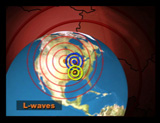ScienceDaily (Aug. 9, 2009) — Daily traffic and noisy machines mask the vibrations caused by earthquakes, making seismic stations unable to detect many M >1 earthquakes. As a result, more earthquakes appear to happen on Sundays and late at night when people and machines are at rest, according to a new study of the apparent daily and weekly periodicity of seismic activity.
"People may think they feel more earthquakes at night or on Sundays, but that's just because it's quiet," says Stephen S. Gao, professor of geological sciences at the Missouri University of Science and Technology (Missouri S&T) and co-author of a study published today in the August issue of the Bulletin of the Seismological Society of America. He co-authored the study with Ali H. Atef and Kelly H. Liu, also of Missouri S&T.
The study used a catalogue of 790,232 earthquakes for the period 1963-2008 which were recorded in Nevada, California and the adjacent Pacific Ocean and found significant peaks for Sundays and the early morning hours. While cyclical patterns do exist in nature, such as the Earth rotating around the Sun, there are no known cyclical events that would explain daily or hourly variations for earthquakes in Western United States. The authors looked to human activity to explain the apparent temporal pattern and found that when cultural noise – or sound made by human activity – was high, such as during the morning rush hour, the ability of seismic networks to detect earthquake activity is low. Moving vehicles on freeways were not the sole source of noise. Busy factories and mines, machinery such as lawn mowers and shaking buildings, caused by the movement of people, contribute to the ambient background noise.
Ali H. Atef, Kelly H. Liu and Stephen S. Gao, Missouri University of Science and Technology were authors of the Bulletin of the Seismological Society of America paper, "Apparent Weekly and Daily Earthquake Periodicities in the Western United States."
Story Source:
Adapted from materials provided by Seismological Society of America, via EurekAlert!, a service of AAAS.
Note: If no author is given, the source is cited instead.


